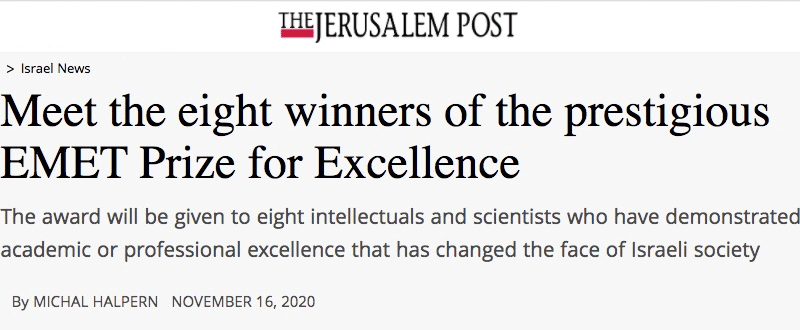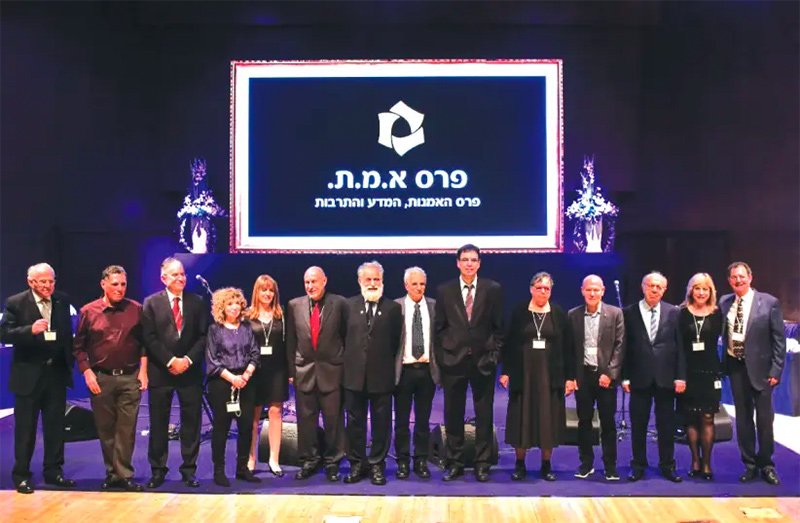

The Israeli scientist who invented a cancer cure without serious side effects; the psychologist who studied human relationships using scientific tools, the architects who designed the country’s landscapes – and more.
Meet the eight winners of the EMET Prize for Excellence.
The EMET Prize for Excellence in Art, Science and Culture has been presented in Israel annually since 2002. As in previous years, this year’s award will be given to eight intellectuals and scientists who have demonstrated academic or professional excellence that has changed the face of Israeli society. The award is bestowed in the presence of the prime minister in five different fields – culture and art, exact sciences, life sciences, humanities, and social sciences.
This year, two prizes will be awarded in nanotechnology, one prize in biochemistry, one prize psychology, two prizes in biblical studies and two additional prizes in architecture. To mark their achievement, we were delighted to speak with the honored and excited winners, whose comments are presented below.
Prof. Yechezkel Barenholz: Excellence in the Field of Nanomedicine
“People who use the drugs we’ve developed tell me that in the morning they get treatment and immediately after that go to work. This is my greatest reward.”
“The facts speak for themselves: small particles can do things that large particles or individual molecules cannot,” says Prof. Yechezkel Barenholz, who received the EMET award for developments in the field of nanomedicine, which is used today to develop advanced drugs. “Because the blood vessels and diseased tissues are slightly ruptured and more perforated compared to healthy tissues, these particles can reach sites selectively, thus reaching cancerous growths and inflammatory or contaminated sites. Thanks to this ability, when these particles reach their destination, they release drugs that are trapped in them, which directly reach the relevant diseased tissue.”
Barenholz’s great discovery led to the development of Doxil, a drug that is used to treat breast and ovarian cancer. Its major advantage stems from the fact that unlike other chemotherapies, this drug does not cause severe side effects like hair loss and vomiting.
“People who use the drugs we have developed tell me that in the morning they receive treatment and immediately after that go to work and continue with their daily routine. The fact that we created a drug that helps people suffer less and live a better quality of life is the greatest reward for me.
“In the beginning, I set a goal – to develop a drug that would enable a quality of life that would also extend life. I am glad that I met this goal and that I could utilize the theoretical knowledge on behalf of applied science that contributed to the lives of patients. I am proud to be among the pioneers who developed one of the most significant directions in drug development. “
Another drug developed by Bernholtz is currently being used for experiments to treat resistant bacteria. This is significant news for the world of science and humanity, as he says that according to forecasts, by the year 2050, the world is expected to face significant mortality due to the problem of resistance to these bacteria. This problem keeps scientists around the world awake at night.
Prof. Reshef Tenne: Excellence in the Field of Nanotechnology
“I was standing in front of the microscope and I couldn’t believe my eyes.”
Prof. Reshef Tenne’s research led to the development of an entirely new field in chemistry, which caused a change in the theoretical principles of the organization of substances in nanoscopic phases and to a change in its practical application.
“In order to develop unique materials in nano-dimensions (small spheres and nanotubes that are about one-thousandth the thickness of a hair), we were required to produce pure phases in considerable quantities,” he explains. “We have developed lubricants that are used by companies for heavy industry. These industries use these tiny particles to produce various lubricants that have a wide range of applications, from turbines and cars to ships to mining.”
According to Tenne, the principles he developed have been incorporated into many modern chemistry and physics texts.
“We incorporate the nanoparticles that we have developed into polymers to improve their mechanical properties as well as their thermal stability. Polymer armor is an issue of immense practical importance in the automotive industry, home accessories, medical devices and more. Recently, we conducted experiments in the field of three-dimensional printing that may be used in the future as part of advanced medical treatment methods,” says the professor.
Regarding his receiving the EMET Prize, Tene says: “We started the journey 29 years ago. The first time we made the discovery, I stood in front of the microscope and could not believe my eyes, which revealed material never known to anyone. Winning this prestigious award gives me a wonderful feeling of fulfillment, and I am grateful for the recognition.”
Prof. Dan S. Tawfik: Excellence in Biochemistry
“Sometimes, I am amazed that I get paid for my work.”
Prof. Dan Tawfik’s research focuses on proteins and enzymes. Professor Tawfik says that these serve as the engine and wheels of living organisms.
“I was fascinated by the abilities of the enzymes,” admits Prof. Tawfik. “The purpose of my research was to examine how they were created in evolutionary processes that affected natural processes and mutations in genes. Indeed, the technologies I developed are now being applied in all kinds of areas of biotechnology. However, it is important to understand that the ability to utilize these insights for their practical applications would not have been possible had we not achieved the basic insight into the processes that we studied.”
Tawfik is delighted to have received the EMET Prize.
“It gives me great pleasure. To be honest, I love what I do so much that sometimes I am amazed that I get paid for doing it, and even more so for winning such a prestigious award.”
Prof. Ruth Feldman: Excellence in Psychology
“We have proven that parenting can also be researched using scientific tools.”
Prof. Ruth Feldman’s research presents a broad approach to the biological basis of kinship and examines how the neurobiological systems and behavioral synchrony that support the parent-child connection are translated into lifelong kinship relationships: with friends, spouses and peers, and how they help develop complex abilities such as empathy, compassion and reciprocity.
In longitudinal studies conducted from infancy to adulthood, Feldman examines how the biological systems that develop in the parent-infant relationship support physical, mental and mental resilience, and how failures that occur in this relationship impair learning development, emotional regulation, stress management, the immune system, brain development and mental health throughout life.
“Our research is guided by broad theoretical questions: the question of the ‘body and mind,’ the question of the person within society, and in general, what makes us human. To answer these questions, we use accurate research tools from various fields: behavioral observations, brain imaging, hormonal testing, genetics and molecular biology. Researchers around the world use the research tools and theoretical models we have built, to build intervention programs for parents and their children.”
Prof. Devorah Dimant: Excellence in Biblical Studies
“I am happy that the field is being recognized.”
Prof. Devorah Dimant was awarded the EMET Prize for her achievements in the study of the Dead Sea Scrolls. Her unique work revealed methods of processing the Bible in later books.
Dimant says that she discovered her unique talent when she was a student at the Hebrew University in Jerusalem. She always knew the answers to questions presented in lectures because she already understood the “way of thinking” of the New Testament, she says.
“The researcher’s work is usually lonely and anonymous, so it is very gratifying that the field is gaining the recognition and recognition that it ultimately presents to the public with this important research work,” the professor said on the occasion of her receiving the award.
Prof. Eliezer Greenstein: Excellence in Biblical Studies
“Always happy to pass on knowledge to the younger generation.”
The award is given to Prof. Eliezer Greenstein for his achievements in Biblical research and for comparing Ugaritic literature with Biblical literature. He says he has not yet achieved all his research goals but greatly appreciates the recognition that he has received.
“In my research, I applied several methods. Among them are methods from the humanities and social sciences, interpretations and literary criticism, psychology, anthropology and translation theory. Of course, I did not give up studying the original texts, but I always made sure to add original literary aspects,” he says.
Greenstein cultivates and promotes future researchers in the field, and to date, 36 doctoral students have completed his studies under his direction.
“I am always happy to pass on the knowledge to the younger generation, and today I also assist young researchers who are not among my students and even the older generation of researchers who are interested in it.”
Shammai Assif: Excellence in Architecture
“Architecture is not only challenging, but it is also strenuous and accompanied by many challenges. I was delighted to receive public recognition.”
Shammai Assif is the recipient of the prestigious award thanks to his hard work in architecture, which has shaped the image of Israel. He is responsible for a wide range of architecture in Israel – from individual buildings and academic institutions, through neighborhood plans and cities, all the way to a national framework. Assif also led the conservation revolution in Tel Aviv-Jaffa and elsewhere in the country.
“We have proven that the preservation of buildings does not constitute a barrier to the development of a city, but on the contrary, leads to prosperity and development. I think Tel Aviv-Yafo is the best example of this,” he says.
Asif was pleased to get the news about receiving the award.
“Architecture is challenging, but it is also strenuous and accompanied by many challenges. I am delighted that the profession to which I have dedicated 50 years of my life has received honor and public recognition. Unfortunately, many public servants engaged in the field do not always receive this recognition. The encouragement I received for my academic work at the Technion also promotes future breakthroughs and contributes to the education of the younger generation.”
Bracha Chyutin: Excellence in Architecture
“An award mixed with sadness and joy.”
For Bracha Chyutin, a veteran architect, receiving the EMET Prize is very emotional.
“Michael Chyutin, my business partner and beloved husband, passed away not long ago, and unfortunately did not get to experience this exciting moment with me. Therefore, for me, receiving the prize for our contribution to the architectural culture in the country is mixed with feelings of sadness and joy.”
The Chyutins established their architectural life’s work in the 1980s and left their mark on many buildings and complexes. She specialized in buildings and he in building cities.
“We had a great symbiosis between us,” says Chyutin. “We have built more and more public buildings and educated an entire generation of architects. We have always believed in the dialogue between the historical context and the contemporary period, and I think that the buildings we have erected represent the matter with honor.”